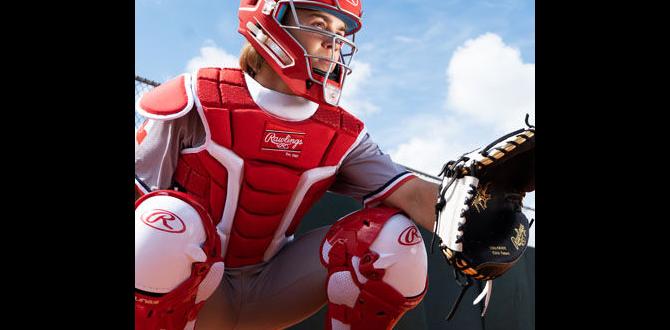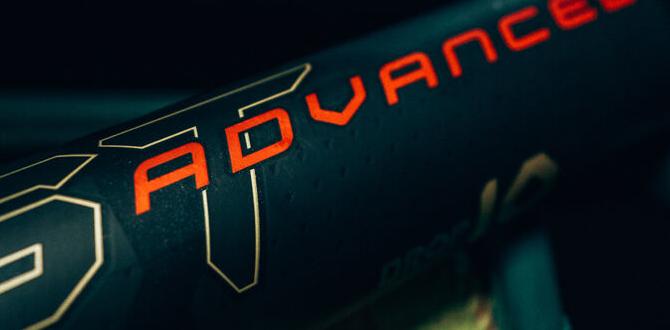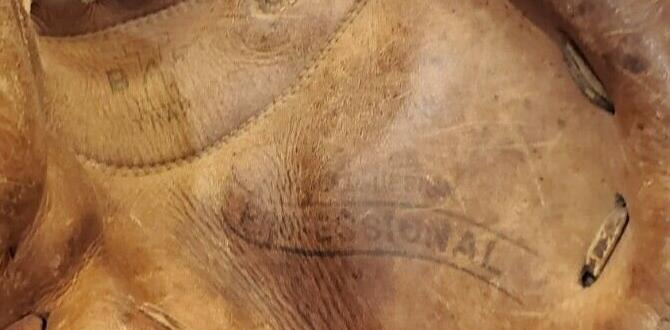Speedy Protection: Catchers shin guards are vital for beginner ballplayers, shielding your legs from errant pitches and foul balls, ensuring comfort and confidence behind the plate.
Hey everyone, John P. Miller here from FriskMode! So, you’re stepping up to the plate, ready to learn the ropes behind the catcher’s mask. That’s awesome! One piece of gear that often gets overlooked by newbies, but is super important, is the catcher’s shin guard. It might not be as flashy as a brand-new bat, but trust me, your shins will thank you later. Getting hit by a pitch or a foul ball can really sting, or worse, injure you. But with the right shin guards, you can focus on the game, not on potential pain. We’re going to break down exactly why these are a must-have and what to look for.
Why Catchers Shin Guards Are a MUST for Beginners
When you’re just starting out as a catcher, your main goal is to learn the fundamentals: framing pitches, blocking, and throwing. You’re also still getting used to the speed and unpredictability of the game. This is where catcher’s shin guards become your best friend. They act as a sturdy barrier between your lower legs and incoming threats – think foul tips, wild pitches, and even accidental collisions.
Imagine this: you’re working hard to block a low pitch, and it bounces unexpectedly, hitting you square in the shin. Without good protection, that could be a painful lesson that sidelines you. With proper shin guards, it’s a much more cushioned encounter, allowing you to recover quickly and stay in the game. It’s all about building confidence and reducing the fear of getting hurt, so you can focus on developing those crucial catching skills.
Understanding Catcher’s Shin Guard Anatomy
Before you go shopping, let’s get to know the parts of a catcher’s shin guard. Knowing these terms will help you understand what makes a good pair and how they work to protect you.
- Shin Plate: This is the main, hard plastic or composite piece that covers the front of your shin and knee. It’s the primary line of defense against impacts.
- Knee Cap: A protective cap that extends over your kneecap, offering crucial protection during blocking.
- Ankle/Foot Protection: Some shin guards have extensions or separate pieces that wrap around your ankle and cover the top of your foot. This adds another layer of safety.
- Straps: Usually Velcro or elastic straps that secure the shin guard to your leg. These should be adjustable for a snug, comfortable fit.
- Padding/Lining: The inner material that provides cushioning and wicks away sweat. Good padding makes a big difference in comfort during long games or practices.
Key Features to Look For in Beginner Shin Guards
As a beginner, you don’t need the most expensive, high-end gear. What you need is reliable protection, a comfortable fit, and durability. Here’s what to prioritize:
Protection Level
For beginners, look for shin guards that offer solid, all-around protection. This means a well-designed shin plate and a sturdy knee cap. You want something that can absorb the shock of a baseball hitting it. Some high-end models have advanced technologies, but for starting out, robust plastic and good padding are key.
Fit and Comfort
This is HUGE. If your shin guards are uncomfortable, you won’t wear them properly, or you’ll be distracted behind the plate. They should fit snugly without restricting your movement. You need to be able to bend your knees, squat, and move laterally. Look for adjustable straps and breathable padding. A good fit means the guards stay in place, no matter how much you move.
Durability
Even beginner gear needs to last. You don’t want to buy new shin guards every few months. Look for well-constructed shin guards made from sturdy materials. Check the stitching on the padding and the quality of the straps. They should be able to withstand the rigors of baseball practice and games.
Size and Length
Shin guards come in different sizes, often based on age or leg length. It’s crucial to get the right size. Too short, and your knees and upper shins are exposed. Too long, and they might be bulky and uncomfortable. Measure your leg from the middle of your kneecap down to the top of your shoe or cleat to get a general idea, and always consult the manufacturer’s sizing chart.
Ventilation
Baseball can get hot! Shin guards can sometimes feel stuffy. Look for models with good ventilation, often achieved through strategically placed vents in the plastic or breathable lining materials. This will help keep your legs cooler and more comfortable, especially during those long summer games.
Top Catcher’s Shin Guard Styles for Newcomers
When you start looking, you’ll see a few main types. For beginners, we generally recommend focusing on models designed for comfort, protection, and ease of use.
Traditional Shin Guards
These are the most common. They typically consist of three main pieces: a large shin plate, a knee cap, and often a smaller piece for the ankle/foot. They offer excellent protection and are generally very durable. They attach with straps and are designed to be worn over your baseball pants.
All-in-One Catcher’s Leg Guards
These are more extensive, covering more of your leg, sometimes all the way up to the thigh. They offer maximum protection and don’t shift around as much due to their more encompassing design. For absolute beginners, especially younger players, these can offer peace of mind. However, they can sometimes be a bit bulkier and hotter than traditional shin guards.
Recommendation for Beginners: For most beginners, a good pair of traditional shin guards strikes the perfect balance between protection, mobility, and comfort. They are less cumbersome and allow for easier movement while still providing excellent coverage of the shins and knees.
How to Properly Fit and Wear Catcher’s Shin Guards
Getting the fit right is just as important as choosing the right pair. Here’s a step-by-step guide:
- Measure Your Leg: Sit on a chair with your foot flat on the floor and your leg at a 90-degree angle. Measure from the center of your kneecap down to where the top of your shoe or cleat sits.
- Consult Sizing Charts: Use your measurement to compare against the manufacturer’s sizing chart. Sizes vary between brands, so always check their specific guides.
- Try Them On (if possible): If you can, try them on at a store. Put on your baseball pants and socks. The shin guard should cover your entire shin and your knee comfortably.
- Adjust the Straps: Once on, adjust the straps so the guards are snug but not cutting off circulation. They should stay in place when you move. The knee cap should be centered over your kneecap.
- Check for Movement: Squat down, bend your knees, and walk around. The shin guards shouldn’t slide down your legs or feel overly restrictive. You should be able to move freely.
- Wear with Pants: Shin guards are typically worn on the outside of your baseball pants. This allows for better protection and prevents them from shifting too much.
Pro Tip: Make sure the straps are secured properly. Loose straps are a recipe for guards that slip, offering less protection and potentially hindering your play.
The Importance of Shin Guards in Baseball Training
Learning to catch isn’t just about having the right equipment; it’s about building good habits and confidence. Shin guards play a key role in this development, especially for beginners.
- Reduces Fear of Injury: When you know your shins are protected, you’re more likely to commit to blocking pitches and get in front of the ball. This fear reduction is crucial for developing confidence.
- Encourages Aggressive Blocking: With good shin guards, you can be more aggressive in your blocking technique. You’re less likely to flinch or pull back when a ball is coming low and fast.
- Facilitates Repetition: The ability to practice without constant fear of pain means more repetitions. More repetitions lead to better skill development. You can focus on the mechanics of blocking rather than the potential consequences.
- Comfort During Drills: Long practice drills can be tough. Comfortable shin guards ensure you can focus on the drill itself, not on how much your legs hurt from impacts or awkward positions.
According to USA Baseball, a national governing body for baseball in the United States, proper equipment, including protective gear, is fundamental to player safety and skill development. Investing in good catcher’s gear, like shin guards, is an investment in a player’s long-term ability to learn and enjoy the game.
Comparing Different Catcher’s Shin Guard Materials
The materials used in shin guards affect their durability, weight, and protection. For beginners, understanding these can help you make a better choice.
Plastic (PVC, Polycarbonate)
Most beginner shin guards are made from durable plastics. These materials are cost-effective, offer good impact resistance, and are relatively lightweight. They are easy to clean and maintain.
Composite Materials
Higher-end shin guards might use composite materials, which can offer superior strength-to-weight ratios. They might be lighter and more durable than standard plastics but often come at a higher price point. For most beginners, robust plastic is more than adequate.
Padding (Foam, EVA)
The inner padding is typically made from EVA (ethylene-vinyl acetate) foam or similar closed-cell foams. This material provides cushioning and comfort. Look for padding that is firm enough to absorb impact but soft enough to be comfortable for extended wear. Moisture-wicking liners are a plus for keeping your legs dry.
A Table of Beginner Shin Guard Considerations
Here’s a quick look at what’s most important when picking out shin guards as a beginner:
| Factor | Beginner Priority | Why It Matters |
|---|---|---|
| Protection | High | Essential for safety and confidence behind the plate. |
| Fit & Comfort | High | Ensures you can move freely and focus on learning. |
| Durability | Medium-High | You want gear that lasts through practices and games. |
| Weight | Medium | Lighter is generally better for mobility, but not at the expense of protection. |
| Price | Medium | Reliable gear doesn’t have to break the bank. |
Maintaining Your Catcher’s Shin Guards
To get the most out of your shin guards and keep them performing well, a little maintenance goes a long way.
- Cleaning: After each use, especially if they’re sweaty, wipe down the exterior plastic with a damp cloth. For the interior padding, you can often remove it or wipe it down with a mild soap and water solution. Ensure they air dry completely to prevent mildew.
- Drying: Never store your shin guards while they are still wet or damp. Always allow them to air dry thoroughly. Leaving them in a closed equipment bag can lead to odors and potential damage to the padding.
- Strap Care: Check the Velcro or ratchet straps regularly for wear and tear. Make sure they are still gripping securely. If they lose their stickiness, you might consider a small Velcro repair kit.
- Inspect for Damage: Periodically check the plastic shells for any cracks or significant damage. Inspect the padding for rips or excessive wear. If damaged, it might be time for a replacement to ensure full protection.
Proper care not only extends the life of your gear but also ensures it continues to provide the protection you need. For more on baseball equipment care, resources like the Baseball America website offer great tips and insights into maintaining all kinds of gear.
Frequently Asked Questions (FAQ) About Beginner Catcher Shin Guards
Q1: How much should I spend on catcher’s shin guards as a beginner?
A: For beginners, you can find excellent, protective shin guards in the range of $50 to $100. While cheaper options might exist, investing a bit more ensures better materials, comfort, and durability, which is crucial for preventing injuries and building confidence.
Q2: What’s the difference between youth and adult shin guards?
A: The main difference is size. Youth shin guards are smaller to fit younger players’ legs. Adult sizes are longer and wider. Always check the manufacturer’s sizing chart as it’s based on leg measurements, not just age.
Q3: Can I wear shin guards under my pants?
A: While some very slim shin guards might allow this, catcher’s shin guards are designed to be worn on the outside of your baseball pants. Wearing them over the pants provides better coverage, stability, and protection against sliding or shifting.
Q4: How often do I need to replace catcher’s shin guards?
A: Shin guards can last for several seasons if properly cared for. You should consider replacing them if the plastic is cracked, the padding is significantly worn or damaged, or the straps no longer secure them properly. For growing young players, replacement may be needed due to size changes.
Q5: Are shin guards really necessary for youth leagues?
A: Absolutely, especially for catchers. Youth leagues can still have fast pitches, and foul balls can be unpredictable. Shin guards are a vital piece of protective equipment that significantly reduces the risk of injury, allowing young players to develop their skills safely and confidently.
Q6: What is the best way to clean the inside padding of shin guards?
A: Many shin guards have removable padding. If yours does, you can usually hand wash it with mild soap and cool water. Gently scrub with a soft brush or cloth, rinse thoroughly, and allow it to air dry completely. If the padding isn’t removable, use a damp cloth with mild soap and wipe it down, then follow up with a clean damp cloth to rinse, and air dry.
Conclusion
So there you have it! As a beginner catcher, your shin guards are more than just an accessory; they’re a fundamental piece of safety equipment that empowers you to play with confidence. By understanding what to look for – solid protection, a comfortable and secure fit, and good durability – you can choose a pair that will serve you well as you develop your game. Remember to get the right size and wear them properly, and don’t forget basic care to keep them in top shape. With the right gear on your side, your focus can be squarely on mastering those skills, blocking those pitches, and enjoying every moment behind the plate. Happy catching!





